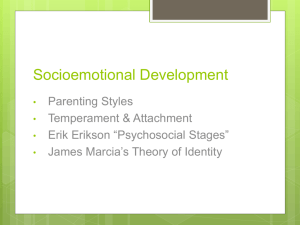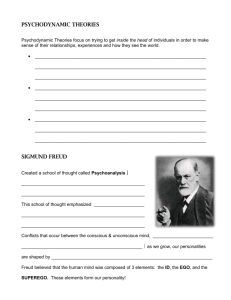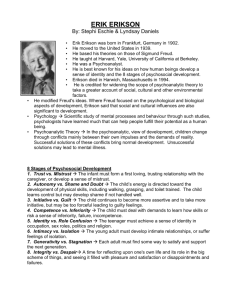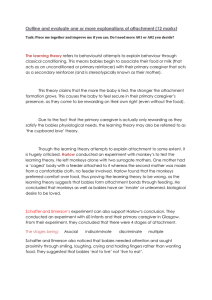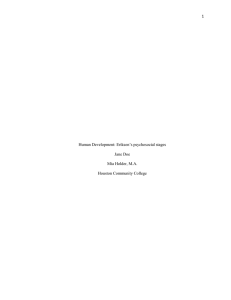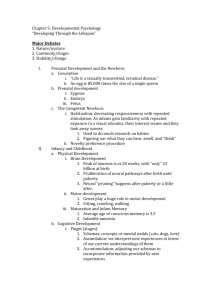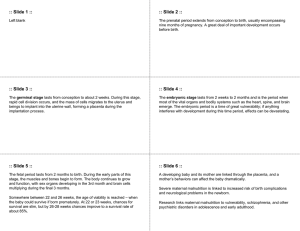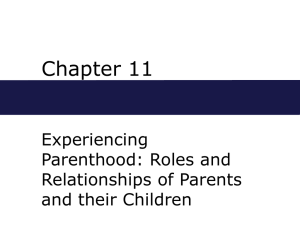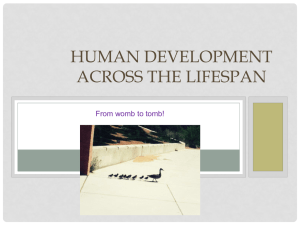Myers Unit 9 -- Kerri
advertisement
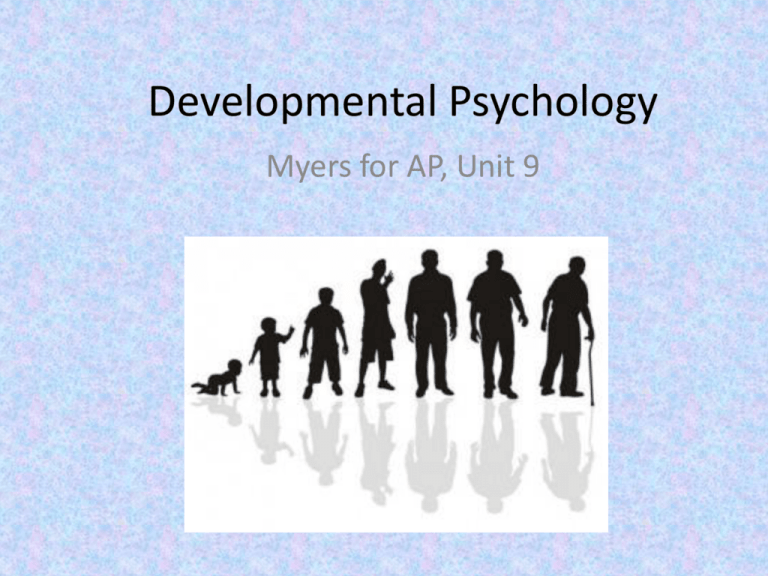
Developmental Psychology Myers for AP, Unit 9 Overview • Do now: What is a placenta and what does it do? • Life is sexually transmitted! • 200 million sperm in an average ejaculate; only one makes it, and fewer than half of those survive two weeks! • It’s a nature/nurture thing all the way along • What are teratogens? Discussion Questions: • Babies! 1. When does life begin? 2. How do you think the criminal justice system should deal with mothers who abuse drugs during pregnancy? 3. Should fetuses be genetically tested for abnormalities? 4. Should human cloning be allowed? 5. What ethical dilemmas exist for doctors and parents when multiple fetuses occur in one pregnancy? Newborns Should Be Able To… • Reflexes: – – – – – Rooting Grasping Moro (startle reflex) Sucking Babinski (toes flare and curl when stroked) – Plantar (toes curl in when ball of foot is pressed) – Stepping – Swimming • APGAR – Test given at 1 and 5 minutes after birth. (Virginia Apgar, 1952). Scores of 7 to 10 are normal. Tests: – – – – – Activity Pulse Grimace Appearance Respiration 1 in 33 babies is born with some kind of birth defect. Causes: teratogens, genetics, and a variety of unknown factors. Babies Learn Fast! • Habituation happens • Babies look longer at novel stimuli • Neural networks grow like wildfire Development basics • Do now: What are the pros and cons of starting very young children in educational opportunities? • There is a nearly universal sequence of growth, although the timeline varies from person to person and culture to culture • Babies growth is cephalocaudal (from head to toe) and proximal-distal (near to far; trunk to limbs) Side notes about SIDS • • • • • • Why do babies die? Sleep apnea Low serotonin levels Back-to-sleep campaign Fumes??? Proximity to mom • Named one of Time Magazine’s most Important people of the 20th Century • Born in Switzerland • His main theory: The driving force of our intellectual development is an unceasing struggle to make sense of our experiences. • Four stages of intellectual development. Some key terms to know: – – – – – Schemas Assimilation Accommodation Object permanence Conversion Jean Piaget 1896-1980 More detail about Stages • Sensorimotor – Reflexes – Primary circular reactions (repeat because pleasurable) – Secondary Circular Reactions (repeat to get a result) – Coordination of reactions – Tertiary Circular reactions (trial and error experiments) – Early representational thought • Preoperational: – Children more adept at using symbols (e.g. a broom is a horse) – Conservation rare in children younger than 5 • Concrete operational – Inductive reasoning (specific to general) – Reversibility: a dog is a Lab and a Lab is a dog (but only on concrete concepts) • Formal operational: – Deductive reasoning – Use of abstract concepts (such as imagining outcomes and consequences of actions NOT based on experiences – The ability to plan organized approaches to solving problems Cognitive Development Reflecting on Piaget’s Theory • Influential theory • Development is more continuous • Larger emphasis on social factors • Lev Vygotsky – Believed learning precedes development – Zone of proximal development Attachment • Do now: Is daycare harmful? • Body contact – Harlow – Parents – peers – partners (natural shift) • Familiarity – Imprinting • Mary Ainsworth – Secure and Insecure Attachment; strange situation research • Sensitive/responsive vs. Insensitive/unresponsive • Parenting vs. temperament • Maternal deprivation vs. father absence • Disruption in attachment (think Harlow baby monkeys in later life) Bowlby & Ainsworth • Bowlby noted for work around attachment and the idea of separation anxiety • Ainsworth: Strange situation studies to determine secure or insecure attachment. – Secure = comfortable playing when mom’s around, distressed when she leaves, happy to see her when she returns. (sensitive, responsive moms) – Insecure = failure to explore, clingy, but may be indifferent when she leaves or returns. (insensitive, non-responsive moms. • Important to note: Much of the research leaves dads out of the picture. (Gender typing) • Also, much of the early research was done and reported by men. Parenting Styles • Authoritarian – “it’s my way or the highway!” (Dictator) • Permissive – “Eh… it’s whatever” (Laissez faire) • Authoritative – “There are rules, but let me listen and explain.” (Democratic) • Diana Baumrind – Children with the highest selfesteem, self-reliance, and social competence usually have which kind of parents? • Discussion question: Are childrearing practices, in general, better or worse in other cultures? Skim through Puberty • • • • • • • Primary sex characteristics Secondary sex characteristics Menarche Girls as early as 9, boys as late as 16 Timing may be different, but progression is the same Advantages and disadvantages of early maturation Brain development. Frontal lobe still developing – explains emotional outbursts, impulsive decisions, risktaking, etc. (e.g. smoking, drinking, early sex, etc.) • Self-focused worry about what others think Erikson Project • Do now: Make a quick list of significant things that typically happen in a person’s life from birth to death. (5 minutes!) • Need volunteers to record on whiteboard. (5 minutes!) • Volunteers mark whether these are physical, social, intellectual. (5 minutes) • Freud said… Freud’s Psychosexual Stages • And Erikson, who followed Freud, said… Erikson Project Continued • Form 5 groups • Each group will have one of the first 5 stages • Follow remaining instructions on SWIFT assignment • Be ready to present tomorrow Do Now: Who am I? (Erikson, Stage 5) • Number your paper from 1 to 10. Write down 10 different answers to this question, listing only those things that, if lost, would make a real difference in your sense of identity. • Ideas include roles, responsibilities, groups, traits, needs, feelings, behavior patterns. For example: “I am kind” or “I am a musician” or “I am a daughter.” • Now, imagine what life would be like if those things were no longer part of your identity. Comment. • Order the list from most important to least. Carol Gilligan Moral Feeling: •Disgust when we see someone do something degrading or subhuman •Elevation when we see someone do something heartwarming, caring, generous or courageous Summing up Three Themes • Nature and Nurture: Both genes and environment; biological and social factors influence our development • Continuity and Stages: Even though stage theory has its flaws, the concepts remain useful and provide context for research and understanding. • Stability and Change: Longitudinal studies have found evidence for both. – Early years can be indicators, but not hard and fast predictors of long-term outcomes – Personality tends to stabilize with age – Temperament is more stable than social attitudes – Stability allows us to depend on others; Change motivates our concerns to create a better future. Oh, and one more thing • Researcher James Marcia expanded upon Erikson's initial theory. • Identity vs. Role confusion: Believed balance = making a commitment to an identity. He developed four different identity statuses: 1. Identity achievement: an individual explores different identities and commits to one. 2. Moratorium: a person is actively exploring different identities, but has not made a commitment. 3. Foreclosure: a person has made a commitment without attempting identity exploration. 4. Identity diffusion: there is neither an identity crisis nor commitment. • Researchers have found that those who have made a strong commitment to an identity tend to be happier and healthier than those who have not. Those with a status of identity diffusion tend to feel out of place in the world and don't pursue a sense of identity.
